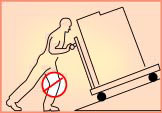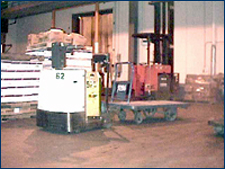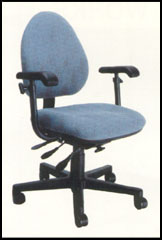Solutions for Electrical Contractors eTool
Ergonomic Solutions » Lower Extremities
The following information describes common ergonomic risk factors (such as standing and kneeling) that may increase the chance of injury and pain to the lower extremities. General solutions that may minimize the possibility of injury and pain to these body parts are also presented.
Potential Hazards

-
Continuously standing in one position causes muscle fatigue and pooling of blood in the lower extremities. This can be painful, lead to the development of varicose veins, and weaken muscles, making them more susceptible to injury.
-
Standing on hard work surfaces, such as concrete, creates contact trauma and pain to feet.
Possible Solutions

-
Provide sit/stand stools at work stations. This provides an opportunity to shift weight from the feet while still maintaining reach and accessibility.
-
Use anti-fatigue mats.
-
Use shoes with well-cushioned insteps and soles where mats are not practical.
-
Provide a foot rest bar so employees can continually alter their posture by raising one foot.

Potential Hazard
-
Lower extremity injuries occur to the knees and ankles during push/pull operations when significant force must be exerted to push heavy loads, or push across non-even or damaged work surfaces, when pushing poorly maintained carts, or when stopping a load.
Possible Solutions


-
Use push/pull aids, such as tugs, when moving heavy loads.
-
Break down large loads to several smaller loads.
-
Use a buddy system when pushing heavy loads.
-
Clear ice, snow, or other debris from travel path before lifting or carrying.
-
Provide clean floors and well-maintained equipment to minimize forces needed to push.
-
Maintain a good coefficient of friction between the floor surface and shoes. Wear shoes with good grips to maintain firm footing.

Potential Hazard
-
Performing prolonged or repeated work activities in the crouching/kneeling position causes reduced blood flow to the lower extremities and contact pressure injuries to the part of the knee coming into contact with hard surfaces.
Possible Solutions

-
Knee pads or foam padding should be used by employees performing prolonged kneeling activities.
-
Stools should be used instead of crouching.
-
When lifting in a cramped area, such as in an aircraft luggage compartment, it is best to perform lifting tasks from a kneeling position and push/pull tasks from a crouched position.
Potential Hazard

-
Carpet layers are subject to "Carpet Layer's Knee" as a result of the contact trauma with the kicker.
Possible Solution
-
Automatic devices should be used if available (for example, carpet layers should use "power stretchers" instead of "knee kickers" to avoid contact trauma and Carpet Layer's Knee).

Potential Hazard
Improper chair height, seating position, or materials may create contact trauma to buttocks and thighs. This may result in uneven weight distribution, contact trauma, decrease in circulation to the lower extremities, irritation, and improper posture.
Possible Solutions

-
The seat pan should be slightly concave with a padded, rounded, or "waterfall" edge. This design will help distribute the weight and may also prevent sliding forward in the chair. A waterfall front edge will reduce contact trauma to the back of the legs.
-
Chairs should be height adjustable, especially in work areas where they are shared by a number of employees.
-
The chair height is correct when the entire sole of the foot can rest on the floor or footrest and the back of the knee is slightly higher than the seat of the chair. This position allows blood to circulate freely in the legs and feet.
-
Where seating must be elevated, provide footrests to support the feet.
For more information on ergonomic chairs see OSHA's Computer Workstations eTool.

